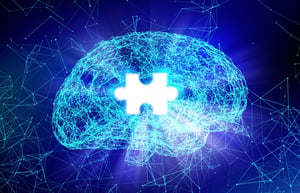
Cerebral small vessel disease is one of the most commonly associated causes of age-related dementia and stroke.
Researchers at the University of Edinburgh may have uncovered the mechanism behind SVD that causes brain cell damage as well as a potential treatment to prevent the damage and possibly reverse it.
The new research studied early pathological features of SVD and found that dysfunction in endothelial cells are some of the first signs of the diseases degenerative progression. These are cells that line small blood vessels in the brain and in early stages of SVD secrete a protein that impairs production of myelin, a compound essential for the protection of brain cells.
These are cells that line small blood vessels in the brain and, in early stages of SVD, they secrete a protein that impairs production of myelin, a compound essential for the protection of brain cells.The hypothesis was that if this endothelial cell dysfunction could be repaired then subsequent brain damage from SVD could be prevented.
The study did successfully treat rats engineered with SVD using drugs that stabilize this endothelial cell dysfunction. Not only did symptoms of SVD disappear but, in early-stages of the disease, the treatment was found to reverse the associated brain damage.
While still in the early stages of research and the effects only being demonstrated in animal models, this underlying endothelial cell dysfunction has been observed in human cases with early asymptomatic SVD. The researchers are hoping to use this new information to move towards an early-stage or preventative drug that limits damaging degenerative effects.
At the very least, the researchers hope this study helps move toward a treatment that could offer an early-stage or even preventative drug that limits the damaging degenerative effects of SVD. Considering the starkly prolific nature of SVD in senior citizens, and the current lack of any direct treatment, this research suggests promising pathways for future study.
We recognize elevated heavy metals that cross the blood brain barrier as risk factors for Alzheimer disease. We test and treat heavy metal toxicity with I.V. ozone chelation therapy. It's safe, effective, advanced treatment that prevents further damage. All ozone and I.V. nutrient therapies are MD/NP ordered in NYS. We add biologics to help reverse SVD damage. We evaluate your diet and assess your blood sugar function in an effort to protect your vessels. We test for VEGF vascular endothelial growth factor to check for oxygen deficiency and tissue damage. Labs are covered by insurance.
Second Nature Care Better Brain Health
Alzheimer's Patients Need to Keep Moving
Haridy, R. (2018, July 06). New drug shows promise for preventing and even reversing damage from age-related dementia and stroke. Retrieved from https://newatlas.com/dementia-stroke-small-vessel-disease-drug-mechanism/55334/?utm_medium=email&utm_campaign=2018-07-06 143646 USA Daily Basic 2018-07-06 144506 AI algorithm teaches a car to drive from scratch in 20 minutes&utm_content=2018-07-06 143646 USA Daily Basic 2018-07-06 144506 AI algorithm teaches a car to drive from scratch in 20 minutes CID_a994fcaa817b6cfafe1ab753125b91ac&utm_source=Campaign Monitor&utm_term=New drug shows promise for preventing and even reversing damage from age-related dementia and stroke


